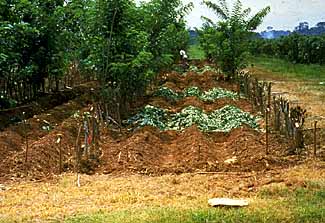An alley cropping system in Nigeria
(Courtesy of Dr. K. Molongoy, International Institute for Tropical Agriculture, Nigeria).|
Alley cropping refers to the growing of crops in alleys between rows of trees or woody shrubs, those most commonly being leguminous species. The trees are fast growing, deep rooted, and if they are legumes, fix nitrogen from the atmosphere. They are able to grow through most of the dry season. The trees or shrubs are heavily pruned at the beginning of the wet season to open up the canopy for annual crops. They may be pruned several more times during the wet season. The prunings are used as a mulch (shown in the photo), which provides nutrients to the annual crops and protects the soil from the direct impact of rain |

|